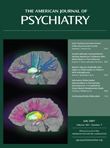To The Editor: Unlike depression and mania, which are recognizable in ancient manuscripts, schizophrenia does not appear in medical literature until much later. It has been suggested that schizophrenia is a modern illness that developed only recently in human history
(1) .
Evans et al. reviewed medical literature from ancient Greece and Rome and noted the lack of mention of a condition that resembles schizophrenia
(2) . Dendle reviewed hundreds of cases of demonic possession from the early Middle Ages and found little evidence of a schizophrenia-like condition
(3) . Torrey and Miller presented compelling evidence that schizophrenia is a modern plague that arose in the 1700s
(4) . The Images in Psychiatry article, published in the December 2006 issue of the
Journal, that featured a drawing by the great Turkish physician Serefeddin Sabuncuoglu provides further evidence from another source and another culture that schizophrenia, as we know it, was not mentioned in more distant times
(5) .
Serefeddin Sabuncuoglu (1385-1470) was a general physician who practiced during the 15th century in central Anatolia, which is now Turkey. Written in Turkish with Sabuncuoglu’s own calligraphy, Cerrahiyyetu’l-Haniyye (Imperial Surgery) is the first known illustrated textbook of surgery and contains colored, handmade miniatures of surgical techniques and instruments
(6,
7) . The book contains Sabuncuoglu’s descriptions of numerous medical conditions and their treatments. Several neurological conditions, including migraine headaches, epilepsy, and tremor are described. The psychiatric conditions described are melancholy (mal-i hulya) and forgetfulness (unutsaguluk). We have carefully reviewed each illustration of Sabuncuoglu’s masterpiece and report that a description of a condition that resembles schizophrenia is not present.
Individuals with schizophrenia may have existed in remote times, but the disorder might have been embedded and obscured within cultures in an acceptable form. Perhaps individuals with schizophrenia were better tolerated during the more simple times of the past. However, we would argue that the devastating nature of the illness that typically robs an adolescent of his or her premorbid personality would be difficult to ignore.
While the absence of any mention of a schizophrenia-like illness in Sabuncuoglu’s textbook does not prove that schizophrenia is a modern epidemic, it provides further evidence that this disorder was not mentioned in yet another ancient culture. If schizophrenia did not exist prior to the 1700s, then one wonders what changes have resulted in the development of the disorder.

